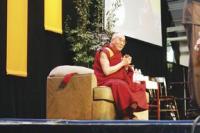
Serving the Vermont Champlain Valley Area for 45 Years
Main SectionsFront Page SportsValley VitalsIt's in the StarsStarwiseArchivesLinksAbout The VoiceContact Us |
Laughter Smiles And Wisdom The 14th Dalai Lama Again Finds Receptive Audience
Tuesday October 16, 2012 By Ed Barna Though Tenzin Gyatso has declared that he will no longer lead Tibet’s government-in-exile, the 77-year-old sage known to the world as the 14th Dalai Lama still commands attention as a spiritual leader. Standing ovations began and ended his presentation to a Middlebury College audience in 2,800-seat Nelson Arena on Oct. 12. There was also elighted laughter, as the Dalai Lama’s showed his ready sense of humor. Asked about the most formative experience of his youth, he said it was playing with toy trains, which distracted him from his lessons. However, he went on, that gave him an intense interest in mechanics, then science, then cosmology and philosophy and Buddhist theology.At the end he said he might come to Middlebury again in another twenty years,possibly in a wheelchair. But his mouth, he said, will still be The Dalai Lama had been to the college before, in 1984 for “Christ and the Education is the root of economic and social development, he said on Friday, addressing in particular the “21st century generation.” But today’s education needs to stop overemphasizing material things, and more to encourage the compassion, affection and respect between peoples that is the basis for finding commonality between differing traditions, he said. Delving into Buddhist philosophy, the Dalai Lama said the purpose of education is to clarify the difference between appearance and reality. To do that, he said, it needs to consider three kinds of facts. But beyond that, the Dalai Lama said, there are the deeply hidden facts that are revealed only through the kind of faith and spirituality that goes beyond reason. His Holiness, as he is commonly known, said that although Buddhists and Jains do not profess a belief in a Creator, he understands how members of faiths that do can use that approach to go beyond selfishness to a greater understanding. As for the Buddha, he said that sage’s advice had been not to take even his words as truth, but rather to investigate for themselves. “I am Buddhist, but I should not develop attachment to Buddhism,” he said. Attachment is biased. The biased mental state cannot see objectively.” A Muslim friend put it well, he said: we must love all the creation of Allah. He contrasted that kind of inclusive love with the type of supposed faith that prays, in effect, “Please bless ME, and all my mischievous activities.” Having one’s mind at peace can also benefit a person’s health, he said. He recounted how he had delayed having an operation on his ailing gall bladder, instead trying traditional Tibetan medicine, until a normally half hour operation took two hours. Then in four days he was ready to leave the hospital, he said. Responding to questions, he may have surprised many by saying that on a 1954 visit to Beijing, he was impressed by Mao Zedong, and found Marxism (though not Leninism) so appealing that he still shares that vision of human equality. Contrasting that view with capitalism, he said it was “not just thinking about profit, but equal distribution,” he said. At that time, Mao’s principle was that without criticism, the Party would die like a fish without water, he said. But returning to China in1956, he found that everything had changed, and dissent was no longer tolerated. Among his more than 80 awards was the 1989 Nobel Peace Prize. Traveling to more than 60 countries and authoring 75 books, he has consistently advocated nonviolent action to promote Tibetan autonomy. Though he is the lama (spiritual head) of Tibet’s most numerous religious affiliation, there are perhaps a hundred such lineages (person-to-person transmissions of understanding) in the region, Waldron said. As the Dalai Lama, he is considered the incarnation of Avalokitesvara, the Boddhisatva of Compassion—a boddhisatva being someone who had reached complete enlightenment but has decided to reincarnate to help others liberate themselves. Tenzin Gyatso has said that when he passes on, he may not reincarnate, thus ending the tradition—or he might reappear outside Tibet, perhaps as a girl. To be declared such a reincarnation, a child must recognize objects from the previous Dalai Lama’s life—which this Dalai Lama did as the two-year-old child of a farming family in northeastern Tibet. On Friday and Saturday, the man who describes himself as “a simple monk” did his best to transmit an appreciation of compassion to additional thousands. , Though the extent to which he did depends on those who encountered him, there was no doubt that in Vermont (which is now home to some of the Tibetan refugees) His Holiness highly and warmly regarded.
|
AdvertisementsSearch our Archives |
Agricultural Weather Forecast:

© 2006-18 The Valley Voice • 656 Exchange St., Middlebury, VT 05753 • 802-388-6366 • 802-388-6368 (fax)
Valleywides: [email protected] • Classifieds: [email protected] • Info: [email protected]

 Printer Friendly
Printer Friendly